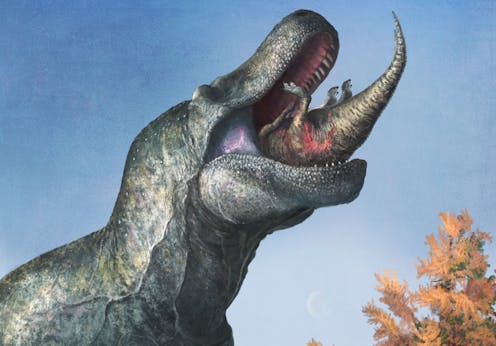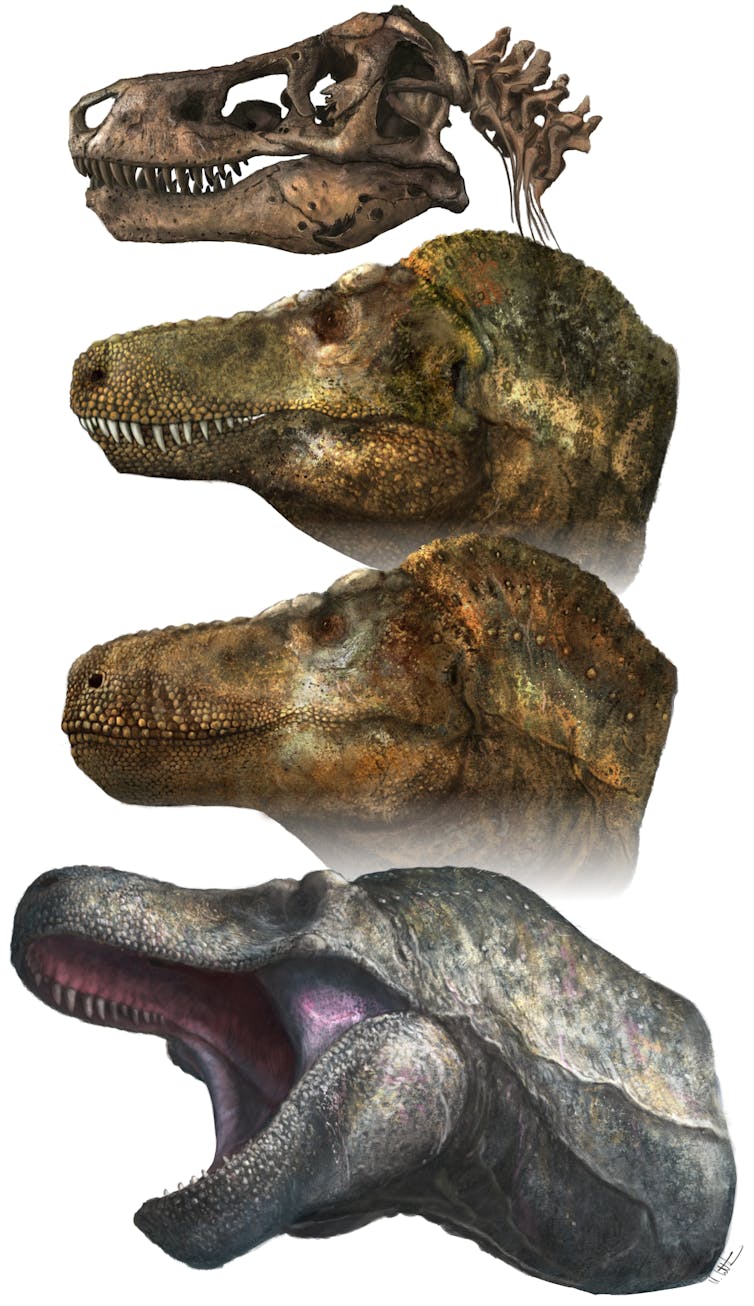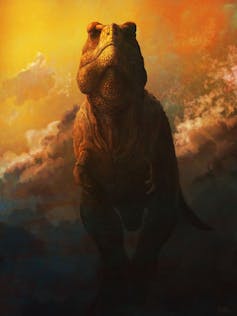
Picture a Tyrannosaurus rex, that ferocious yet one of the most beloved dinosaurs. Most people will probably imagine a scaly giant with enormous fangs, visible even when its mouth is closed.
This is the image of toothy predatory dinosaurs that popular culture has perpetuated for over 30 years.
But our new study, published in Science, suggests that even the giant teeth of Tyrannosaurus would have been sheathed in scaly lips.
Palaeontologists and artists have held different opinions on how dinosaur faces looked since we began recreating their form in the 1830s. From the 1980s onwards, artists and scientists have mostly shown theropod dinosaurs (the lineage that includes Tyrannosaurus, Velociraptor and birds) with lipless mouths and exposed teeth.
This look became deeply rooted in popular culture thanks to the 1993 film Jurassic Park and its iconic depiction of T. rex. Jurassic Park’s creators deliberately exaggerated the size and visibility of their tyrant’s teeth, despite being an otherwise accurate recreation of Tyrannosaurus for the time. No specific study or fossil discovery inspired this look. The widespread adoption of the lipless dinosaur reflected a preference for a new, ferocious-looking aesthetic rather than a scientific re-think.
This is not to say that lipless theropods are scientifically baseless. Living cousins of dinosaurs, the crocodylians (crocodiles and alligators), and the only surviving dinosaur group, birds, both have hard, immobile tissue around their jaws rather than the scaly lips of lizards. So it was reasonable to infer that extinct animals related to crocodylians and birds (including all predatory dinosaurs) had lipless faces.

Our new study, 11 years in the making, brings new data to this conversation. My team analysed theropod fossils and compared them with living reptiles. We found that predatory dinosaurs probably had lips like those you’d find on a lizard.
One part of our research looked at tooth damage. Exposed teeth show greater wear than those behind lips – for example, crocodylians have significant abrasion on their outer teeth. But when we examined theropod teeth using microscopes and compared them with crocodylian teeth, we found theropod teeth were considerably less damaged.
This is not the only difference between theropods and crocodylians. All reptiles have small holes in their jaw bones that house blood vessels and nerves for their oral skin and gums, usually just millimetres wide.

Lipped reptiles, lizards and tuataras (the last survivors of a group of lizard-like reptiles from the age of dinosaurs), have relatively few of these holes and they are mostly positioned close to their teeth. Crocodylian skulls, however, are covered in hundreds of tiny openings that are related to their sensitive, tight facial skin.
We found theropod jaw bones are more like lizards’ and have a low number of openings close to their jaw margins. This is also true of crocodylians’ ancient, extinct relatives. This implies that the unusual facial anatomy of living crocodylians evolved within their own lineage, not as a shared feature with the dinosaur/bird line.
We also looked at tooth size, because some predatory dinosaurs had much bigger teeth than any living reptiles, and this might have prevented them from being enveloped inside lips. We calculated a ratio of tooth height and skull length for theropods. Then we compared this with the same value for monitor lizards, the lipped group that includes the only living animal comparable to large theropods in its feeding habits, the komodo dragon.
Our comparisons revealed that no predatory dinosaurs – even the big-toothed T. rex – had teeth larger than living lizards. Indeed, species like the crocodile monitor have proportionally larger teeth than any theropod, so there’s no reason to think dinosaur teeth were too big to be covered by lips.
Finally, we modelled the mechanics of how lipless theropod jaws would close, and found it impossible for some theropods to seal their mouths without lips. The best we could manage was a gappy smile. Forcing jaws into a full seal either crushed jaw-supporting bones or dislocated the jaw joint. With permanently open mouths, these theropods would have faced issues with their oral health and risked dehydration.
Collectively, these studies point to the same conclusion: that theropod mouth anatomy and functionality seems more like that of lizards than crocodiles. This suggests that lizard-like lips covered their teeth.
If we’re right, and lizards are our best model for theropod mouths, dinosaur lips were probably not muscular, like mammal lips are. So, dinosaurs probably couldn’t snarl like they sometimes do in the movies.
In further contrast with Hollywood’s dinosaurs, we also need to give theropods bigger gums. Unlike crocodiles or even mammals, lizard-line reptiles tend to have large gums that cover some or all of their tooth crowns, even when their teeth are adapted for ripping flesh. This has the effect of making their teeth look smaller or even invisible in their open mouths.
Combined with scaly lips, our findings suggest that predatory dinosaurs may have had softer-looking faces and mouths than we’re used to. But don’t let this fool you. Behind those lips and gums were the same formidable, flesh-rending teeth.
Mark P. Witton does not work for, consult, own shares in or receive funding from any company or organisation that would benefit from this article, and has disclosed no relevant affiliations beyond their academic appointment.
This article was originally published on The Conversation. Read the original article.







